The Chariot of Dhamrai
The Chariot of Dhamrai, engraved so beautifully
Over how many years by which old carpenter of
ancient times
Whose skilled hands took hold of the blade
And curved over the hard wood
Images of fairies and flowers and forests.
In front of the chariot, a pair of horses
Are on the run from time immemorial.
They are still running and have not stopped ever since
Then came the folk painter whose touch of fine brush
Brought down from heaven many god and goddesses
And entaged them on the body of the Chariot
With the magic colour and lines to live forever.
What a great consolation he has created
On the body of this mortal world!
Krisna is leaving Mathura, the milkmaids
Lay underneth the Chariot wheels
Begging Lord of Love, do not leave us in pretence.
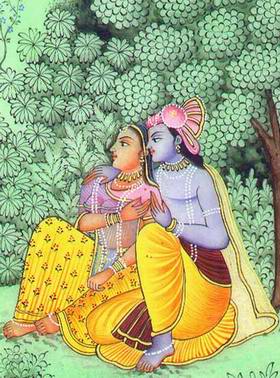
And his beloved Radha, alas, her sorrows
Surpassing years and years
Are still pouring forth through the lines
On the rural painter.
Twice a year fairs were held around the Chariot
Shops and stalls and circus parties
Gathered on those occasions
To the tune of gazi songs;
Accompanied by the sweet sound of earthen drums
Many kings and queens used to roam about.
And they created the atmosphere of glorious deeds
In the folk tunes the ideology of mortality and justice
Soothed the ears of young and old,
Who was the enchanter who built this temple out of
scanty wood.
What depth of affection evoked from his heart
That millions of people made pilgrimage to see chariot
And light the lamp of devotion?
Thae gurdians of pakistan in the guise of false saviours
Burnt this beautiful chariot to ashes.
Agreat consolation for generations after generations
For the work that had come from the hands of the artist
What barbarian destroyed the solace forever.
( Translated by: Hasna Jasimuddin )
Back to Content
|
9. Burnt Village
Back to Content
10. Where is Mina?
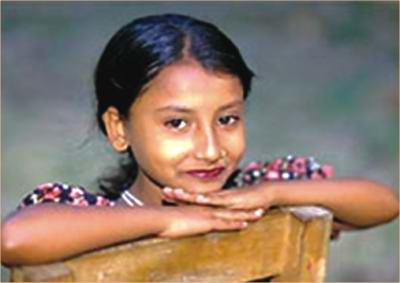 Where is Mina gone? Where is Mina gone?
aha- the little shiny girl like a doll
to merely look at her affection flows without bound
the little sweetheart she talks endlessly
her words blossom into wonderous flowers
and rush to the air and sky
to look at her you would think poetry has covered
the whole earth.
............................
Their village is surrounded by the pirates
everyhome burns to the ground
the little girl, to pick her up in the lap
would only be rational thing
who could kill her, can any one so cruel?
can you crush littleBulbuli bird
with cold grasp of hands closing on her little soft throat?
...........................................................
the frightend fawn had perhaps run towards the woods
but in vain
the arrow had striken her as it had many others
my little Mina I cry for every where
will my cry be heard by some kind heart?
(Translated by Hasna Jasimuddin)
Back to Content
11. The last poem for you
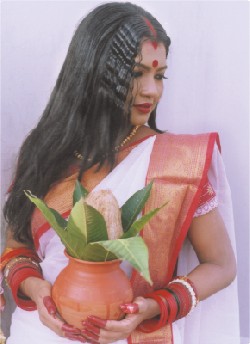 |
To write a poem for you one will have to give his life
the blossom of happiness will wilt before the scent is tasted
his home will burn to give you shelter
to make you his own his people will turn strangers
whose backyard is his boundry
where will he seek shelter
the soldiers have covered all corners
your whole body is adorned with paddy stalks
such beauty, lovely daughter, is your enemy
the soldiers are after you and the bayonets speak
their desires
dear daughter, where shall I hide you
where shall I find cool shade of a tree soothe you
all around us lie dry sand
where the tiger hesitates to kill man
these men don't
what men are these to drive their brothers into
the depths of the jungles
even there he is pursued
what poem shall I write you
can I bring you a blessing from the seven seas
that will free you and your two feet
will be painted with the red of the pirates.
there are no tears, no sighs, no farewll songs
corpse of father lies holding the young son's body
they will not console one another
the young husband lies beside his bride
words of love will remain unsaid
dead mother - and her child
will rot in the monsoon rain
love has died, mercy has died
only mother earth cries as the winds wails softly softly.
(Translated by Hasna Jasimuddin)
|
Back to Content
12. Song for Independence
|
Back to Content
13. Gazir Gaan
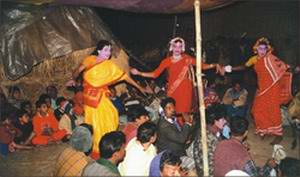
The Fokre Paala of the Gazir Gaan (The Ascetical Drama of the Gazi Song) Dudhshar, a village in Shailkupa thana in Jhenaidaha district. There resides Rowshan Ali Jowardar, one of the lead singers or narrators (Gayen) of the Gazir Gaan (Gazi's song). The all time involvement with his performance keeps this man away from his home most of the time. In his absence, I get the address of Bhola, the leader of the troupe who resided in Bhatoi Bazar and succeed to meet him.
The Gazir Gaan singers and the instrumentalists took their seats facing north on the square shaped mat. Then commenced the starting ritual. As the lead singer implanted the symbolic icon, Gazir Asha (Hope of Gazi) north of the audience, music played on. Among the musical instruments were flutes, harmonium, juri or Mandira (a small hollow pair of cymbals) and the dhol (instrument of percussion which is not so much in width as a drum but longer in size). After the group instrumental, the lead singer presented a devotional song with his troupe accompanying him in stages.
If you come, Oh Merciful to rescue the destitute / (Merciful) Please take and make me cross
(I) do not offer my prayers, nor do I fast / Please have mercy and make me cross
(I) coming into this world / about you I have forgotten/ under the spell of infatuation . . .
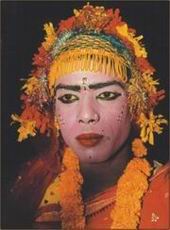 Each individual has the knowledge of good or bad and for the singers and the spectators or the audience of Gazir Gaan, the performance is as recreational as it is of devotion. Some show their devotion by praying, some by worshiping (Puja), some by offering a particular sacrifice to the deity on fulfillment of a prayer (Manot) and some may look for some other way to express their devotion. Gazir Gaan, whatsoever includes humour or even obscenity, ultimately it is something of sheer devotion. Each individual has the knowledge of good or bad and for the singers and the spectators or the audience of Gazir Gaan, the performance is as recreational as it is of devotion. Some show their devotion by praying, some by worshiping (Puja), some by offering a particular sacrifice to the deity on fulfillment of a prayer (Manot) and some may look for some other way to express their devotion. Gazir Gaan, whatsoever includes humour or even obscenity, ultimately it is something of sheer devotion.
There are altogether 7 Paalas (episodes) in the Gazir Gaan performance:
1. Marriage 2. Didar Badshah 3. Dharma Badshah 4. Erong Badshah 5. Taijel Badshah
6. Tara Dakait 7. Jamal Badshah
But the performance commences with the "Fokre Paala" depicting the story behind Gazi and Kalu's becoming ascetics after which continues seven episodes. Gazi is very serious and sincere in his work, while the character of his brother Kalu is more comical and he is the one who creates the humour through his role. Through his jeers and meaningless dialogue and activities he very skillfully takes the audience into the embedded sorrow and depth of the story. Here are some quotes from the "Fokre Paala". After the dance performed by the "Chukris", the lead singer stands up and delivers some introducing words in his local accent.
After the introductory words of the narrator, starts the instrumental and then the Dhua or starting chorus of the narrative passes from the lead singer to his members of the chorus.
Singer starts the main narration of the Fokre Paala of Gazi and Kalu and at the beginning he requests Kalu earnestly to become Gazi's companion in his quest of becoming an ascetic leaving behind the earthly pleasures and luxury. As this song ends Kalu comes up and takes part in dialogue (in verse and prose)based drama with the lead singer. The statements and their replies are rather nonsense, comic in nature and sometimes with the use of indecent words (Saymon Zakaria, August 30, 2004)
|
A tradition which ridicules the clash of civilisations
The Legend of Gazi
Gazi Pir was a Muslim saint who is said to have spread the Islamic religion in Bengal. According to local myth, he could control dangerous animals and make them harmless and gentle. He is shown riding a fearsome Bengal tiger while holding a poisonous snake in his hand without coming to any danger. He also battled with the crocodiles who were a constant threat to the people of the area called the Sunderbans, the watery jungle where the river Ganges meets the sea. Through his influence over all of these animals, he is said to have made it possible for people to live and farm in that jungle and people still pray to him to protect them while they go about their daily chores.
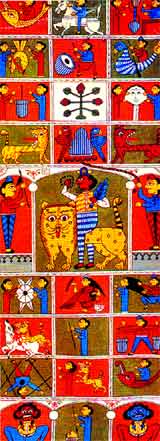 When we talk about patchitra, first of all, the images of Kalighater pats come in our mind. This genre of painting developed in the nineteenth century which flourished in the market places around the Kalighat Mandir on the bank of the Ganges in Kolkata. But according some historians, older than the Kalighater pat were Gazir pats which most probably emerged around the 16th century. Unlike the Kalighater pat, the uniqueness of Gazir pat is of profound importance and influence in the history of painting and literature in Bengal both in subject and form. The scroll paintings of Gazir pat (pat meaning cloth), present the valour of legendary figure Gazi Pir, who was respected and worshiped as a warrior-saint. When we talk about patchitra, first of all, the images of Kalighater pats come in our mind. This genre of painting developed in the nineteenth century which flourished in the market places around the Kalighat Mandir on the bank of the Ganges in Kolkata. But according some historians, older than the Kalighater pat were Gazir pats which most probably emerged around the 16th century. Unlike the Kalighater pat, the uniqueness of Gazir pat is of profound importance and influence in the history of painting and literature in Bengal both in subject and form. The scroll paintings of Gazir pat (pat meaning cloth), present the valour of legendary figure Gazi Pir, who was respected and worshiped as a warrior-saint.
Gazir Pir is not mentioned in history, according to some scholars, the Muslim saint Gazi, might have appeared around the 15th century and seemed to be related to the rise of Sufism in Bengal. Islam Gazi, a Muslim general, served Sultan Barbak (1459-74) in Delhi and conquered Orissa and Kamrup (now Assam). Towards the end of the 16th century, Shaikh Faizullah praised the valour and spiritual qualities of this general in his verse Gazi Bijoy, the victory of Gazi.
To the worshipers of Gazi, this warrior-saint protected his devotees from attacks of wild animals and demons in the forests. In Bangladesh, particularly, in the regions of the Sundarban, the story and images of Gazi Pir had earned much popularity among the forest dwellers, like woodcutters, beekeepers and others. These communities still believe in the supernatural powers of the Pir and utter his name when they venture in to the forest.
In the plains, Gazi is worshiped as the protector against demons and harmful deities and saves them from all sorts of dangers. The villagers usually call the gayens or folksingers, who know the story of Gazi Pir to sing the saint? praise
The singers·preaching created a demand for the pats among the devotees, irrespective of caste, creed and community and the pats had gained a huge popularity in the rural areas across the country, in the early years. Traditionally, the singers were Muslims while the patuas belonged to the Hindu religion. Sadly, at present, this combined form of art, paintings on pats and rendering of Gazir praise, has lost its purpose as a savoir from evil.
Until the recent past, the narration of the story of Gazi Pir with the help of a Gazir pat was a popular form of entertainment in rural areas, especially in greater Dhaka, Mymensingh, Sylhet, Comilla, Noakhali, Faridpur, Jessore, Khulna and Rajshahi.
Gazir pat has specific images painted on a single canvas which have remained unchanged through the centuries. These images have been honoured as sacred symbols of good omen. There are twenty seven panels in a traditional Gazir pat, which measures 60 inches X 22 inches. The ankaiya (painter) follows the traditional styles in depicting the images. In the twenty-seven panels, the ankiya draws the images of a shimul tree; a cow; drum to depict triumph of Kalu Gazi; sawdagar or merchant; a deer being slaughtered; Asha or hope, the symbol of Gazi; Kahelia; Andura and Khandura; tiger; umbrella in the hand of Gazi? disciple; Suk and Sari birds sitting on the umbrella; Lakhmi; charka, the spinning wheel; two witches; goala or milkman; mother of the goala; a cow and a tiger; an old woman beautifying herself; Baksila; Ganga; Jamdut; Kaldut; mother of Jam raja; and in the centre Gazi riding on a tiger. The singer or singers narrate sometimes the night long story, pointing at the characters, which appear in the twenty seven panels of the pat.
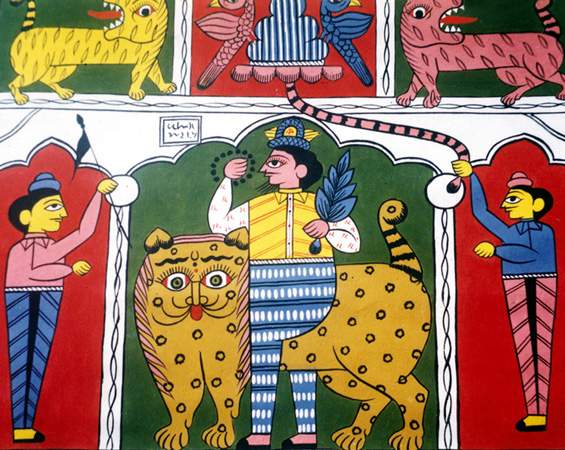 Red and blue are the two pigments mainly used in the pats. There are slight variations of colour, with crimson and pink from red, and grey and sky-blue from blue. Every figure is flat and two-dimensional. In order to bring in variety, various abstract designs (such as diagonal, vertical and horizontal lines and small circles) are often used. Trees, Gazi? mace, the tasbih or prayer beads, birds, deer, hookahs etc, are extremely stylised. The figures of Gazi, his disciples Kalu and Manik Pir, Jama? (the Hindu god of death) messengers, etc appear rigid and lifeless. Though there is no attempt at realism in the images of Gazir pats, the sort of painting has a time value as primitive work. Red and blue are the two pigments mainly used in the pats. There are slight variations of colour, with crimson and pink from red, and grey and sky-blue from blue. Every figure is flat and two-dimensional. In order to bring in variety, various abstract designs (such as diagonal, vertical and horizontal lines and small circles) are often used. Trees, Gazi? mace, the tasbih or prayer beads, birds, deer, hookahs etc, are extremely stylised. The figures of Gazi, his disciples Kalu and Manik Pir, Jama? (the Hindu god of death) messengers, etc appear rigid and lifeless. Though there is no attempt at realism in the images of Gazir pats, the sort of painting has a time value as primitive work.
Gazir Gan songs to a legendary saint popularly known as Gazi Pir. Gazi songs were particularly popular in the districts of faridpur, noakhali, chittagong and sylhet. They were performed for boons received or wished for, such as for a child, after a cure, for the fertility of the soil, for the well-being of cattle, for success in business, etc. Gazi songs would be presented while unfurling a scroll depicting different events in the life of Gazi Pir. On the scroll would also be depicted the field of Karbala, the Ka'aba, Hindu temples, etc. Sometimes these paintings were also done on earthenware pots.
The lead singer or gain, wearing a long robe and a turban, would twirl an asa and move about in the performance area and sing. He would be accompanied by drummers, flautists and four or five dohars or choral singers, who would sing the refrain.
Gazi songs were preceded by a bandana or hymn, sung by the main singer. He would sing: 'I turn to the east in reverence to Bhanushvar (sun) whose rise brightens the world. Then I adore Gazi, the kind-hearted, who is saluted by Hindus and Mussalmans'. Then he would narrate the story of Gazi's birth, his wars with the demons and the evil spirits, as well as his rescue of a merchant at sea.
Although Gazi Pir was a Muslim, his followers included people from other religious communities as well. Many Gazi songs point out how people who did not respect him were punished. At least one song narrates how Gazi Pir saved the peasantry from the oppression of a zamindar. Another song describes how a devotee won a court case. In Gazi songs spiritual and material interests are often intertwined. The audience give money in charity in the name of Gazi Pir. This genre of songs is almost extinct in Bangladesh today. [Ashraf Siddiqui]
The tradition of Gazir pat can be traced back to the 7th century. It is also possible that the scroll paintings of Bangladesh are linked to the traditional pictorial art of continental India of the pre-Buddhist and pre-Ajanta epochs, and of Tibet, Nepal, China and Japan of later times.
|
Civilisations are built on the exchange and encounter of different cultural traditions.
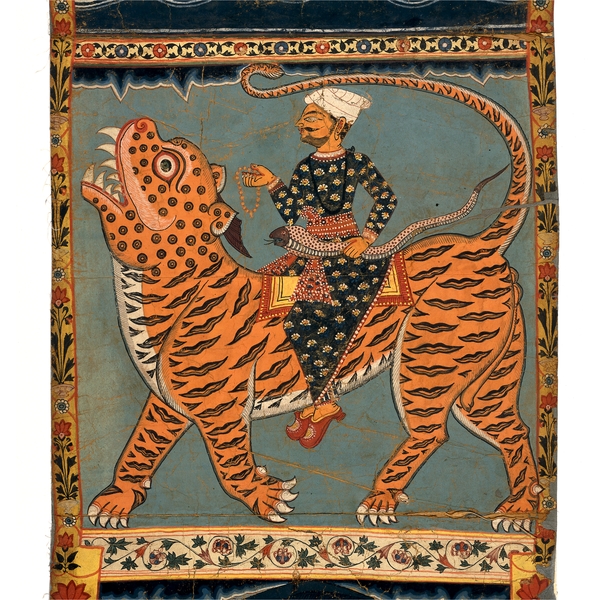 One of the most striking exhibits in the current British Museum exhibition Myths of Bengal is the beautiful Gazi scroll - not just for its rich colours and vivid figures, but because it illustrates the enriching coexistence of two of the world's great faiths. Images of Hindus making puja offerings are juxtaposed with those of Muslims making similar offerings at the tombs of their saints (pirs). It shows how a remarkable, syncretic culture emerged in which the tombs of many pirs became places of pilgrimage for both Hindus and Muslims.
One of the most striking exhibits in the current British Museum exhibition Myths of Bengal is the beautiful Gazi scroll - not just for its rich colours and vivid figures, but because it illustrates the enriching coexistence of two of the world's great faiths. Images of Hindus making puja offerings are juxtaposed with those of Muslims making similar offerings at the tombs of their saints (pirs). It shows how a remarkable, syncretic culture emerged in which the tombs of many pirs became places of pilgrimage for both Hindus and Muslims.
The syncretism is also evident in the Bengali tradition of bauls, itinerant singers who came from both faiths and used the same songs, full of the yearning of the humble man for God. These songs were a great inspiration to the Bengali Hindu poet Rabindranath Tagore (whose paintings are also on show at the British Museum) and expressed the same sentiments found in both religious traditions. The national anthems of the predominantly Muslim country of Bangladesh and the predominantly Hindu country of India were both written by Tagore.
In his most recent book, Identity and Violence, Amartya Sen, a Bengali, describes how civilisations are built on the exchange and encounter of different cultural traditions. It is both an impoverishment and a deeply dangerous development to recast the identity of regions in terms of just one faith. He cites Tagore, who described his family background as a "confluence of three cultures, Hindu, Mohammedan and British".
Bengal has been one of the world's great melting pots, perhaps the place where east has met west for the longest period of settled coexistence. For more than 200 years it was at the heart of Britain's power in India, and Calcutta was the second city of the British empire. British rule brought shocking misgovernment, such as the Bengal famine of 1943 and economic exploitation, but it also brought western ideas, producing a vibrant cultural life in the 19th century.
Vestiges of the syncretism survive, despite the fact that West Bengal is now largely Hindu, and Bangladesh Muslim, but the process of erosion grinds on. In both countries, wealthier diasporas exacerbate the sharpening of antagonistic religious identities. The faith of huge numbers of Bangladeshi migrant workers now owes more to a global Islam influenced by Saudi Arabia than to Bengal's traditional Sufism. Upward social mobility in the villages of Sylhet - the region from which most British Bangladeshis come - is associated with a rejection of the folkloric piety in which even Bengal's pre-Islamic Buddhism was discernible.
Looking at the Gazi scroll, one cannot but conclude that the past offers more enlightened models of living with difference than we are achieving.
We need to be reminded - and inspired - by the history of places such as Bengal so that we can guard against the easy simplification that human beings can be parcelled into discrete civilisational categories based on faith. Some of the world's richest cultural traditions are the legacy of the interaction of several faiths (Madeleine Bunting
Wednesday November 29, 2006,The Guardian) .
Back to Content
14. The War for Bangladeshi Independence, 1971-
Conclusion
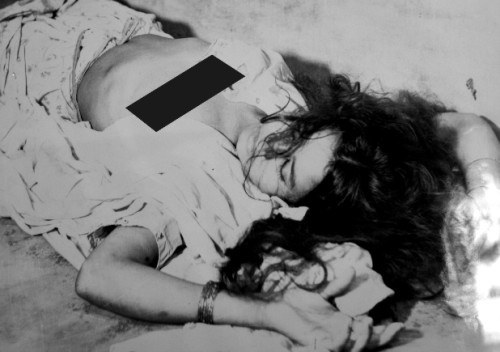 |
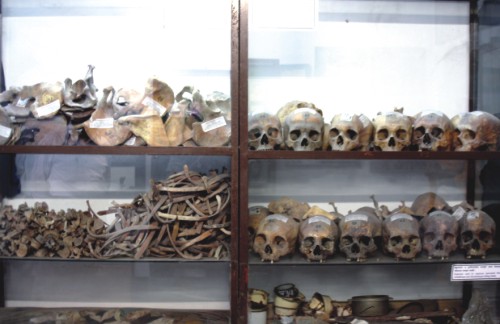 |
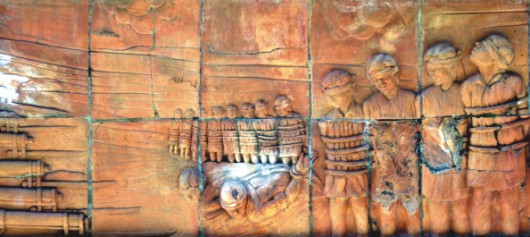
The systematic and cold-blooded abduction, torture, rape and killing of civilians from all walks of life by the Pakistani Army are a painful part of the history of our independence. What is even more irreconcilable is the fact that our own people, i.e. Bangalis joined hands with them and became collaborators of this gruesome plan to cripple a population physically, intellectually and psychologically through Nazi-like operations. The legacy of the Pak Army -- with the help of the collaborators they thought they would maim the nation by murdering the intellectuals
The paramilitary force Al-Badr, along with Al Shams and Razakar Bahini was formed in September 1971 under the auspices of General Niazi, chief of the Eastern Command of the Pakistan Army. Their objective was to strike panic into the people by abduction and killing. It was the military adviser to the Governor, Major General Rao Forman Ali who masterminded the whole conspiracy to extinguish the intellectuals and the higher educated class. The Al Badr paramilitary force was a special terrorist faction of the then Jamaat-e-Islami.
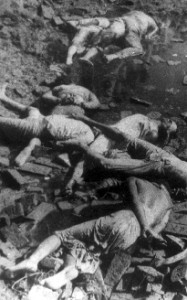 The collaborators helped the Pak Army to find those on their deadly list, round them up or abduct them and then take them to various places where the victims were brutally tortured and murdered. Their bodies were dumped in various killing fields, the most infamous one being the Rayerbazar Bodhobhumi (killing field) where the mutilated bodies of victims were later found. Many of the bodies were unrecognisable, some had body parts missing, while others' eyes had been gouged out. Among the victims were many intellectuals, university professors, doctors, writers and journalists. The bodies of other victims were never found. The Pak Army and their collaborators also picked up many women and young girls who were subjected to systematic rape and torture. The collaborators helped the Pak Army to find those on their deadly list, round them up or abduct them and then take them to various places where the victims were brutally tortured and murdered. Their bodies were dumped in various killing fields, the most infamous one being the Rayerbazar Bodhobhumi (killing field) where the mutilated bodies of victims were later found. Many of the bodies were unrecognisable, some had body parts missing, while others' eyes had been gouged out. Among the victims were many intellectuals, university professors, doctors, writers and journalists. The bodies of other victims were never found. The Pak Army and their collaborators also picked up many women and young girls who were subjected to systematic rape and torture.
 On March 25, the Pakistan Army launched a terror campaign calculated to intimidate the Bengalis into submission. Within hours a wholesale slaughter had commenced in Dhaka, with the heaviest attacks concentrated on the University of Dhaka and the Hindu area of the old town. Bangladeshis remember the date as a day of infamy and liberation. The Pakistan Army came with hit lists and systematically killed several hundred Bengalis. Mujib was captured and flown to West Pakistan for incarceration. On March 25, the Pakistan Army launched a terror campaign calculated to intimidate the Bengalis into submission. Within hours a wholesale slaughter had commenced in Dhaka, with the heaviest attacks concentrated on the University of Dhaka and the Hindu area of the old town. Bangladeshis remember the date as a day of infamy and liberation. The Pakistan Army came with hit lists and systematically killed several hundred Bengalis. Mujib was captured and flown to West Pakistan for incarceration.
To conceal what they were doing, the Pakistan Army corralled the corps of foreign journalists at the International Hotel in Dhaka, seized their notes, and expelled them the next day. One reporter who escaped the censor net estimated that three battalions of troops--one armored, one artillery, and one infantry--had attacked the virtually defenseless city. Various informants, including missionaries and foreign journalists who clandestinely returned to East Pakistan during the war, estimated that by March 28 the loss of life reached 15,000. By the end of summer as many as 300,000 people were thought to have lost their lives. Anthony Mascarenhas in Bangladesh: A Legacy of Blood estimates that during the entire nine-month liberation struggle more than 1 million Bengalis may have died at the hands of the Pakistan Army.
The West Pakistani press waged a vigorous but ultimately futile campaign to counteract newspaper and radio accounts of wholesale atrocities. One paper, the Morning News, even editorialized that the armed forces were saving East Pakistanis from eventual Hindu enslavement. The civil war was played down by the government-controlled press as a minor insurrection quickly being brought under control.
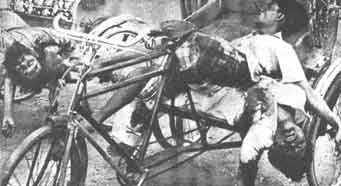 After the tragic events of March, India became vocal in its condemnation of Pakistan. An immense flood of East Pakistani refugees, between 8 and 10 million according to various estimates, fled across the border into the Indian state of West Bengal. In April an Indian parliamentary resolution demanded that Prime Minister Indira Gandhi supply aid to the rebels in East Pakistan. She complied but declined to recognize the provisional government of independent Bangladesh. After the tragic events of March, India became vocal in its condemnation of Pakistan. An immense flood of East Pakistani refugees, between 8 and 10 million according to various estimates, fled across the border into the Indian state of West Bengal. In April an Indian parliamentary resolution demanded that Prime Minister Indira Gandhi supply aid to the rebels in East Pakistan. She complied but declined to recognize the provisional government of independent Bangladesh.
A propaganda war between Pakistan and India ensued in which Yahya threatened war against India if that country made an attempt to seize any part of Pakistan. Yahya also asserted that Pakistan could count on its American and Chinese friends. At the same time, Pakistan tried to ease the situation in the East Wing. Belatedly, it replaced Tikka, whose military tactics had caused such havoc and human loss of life, with the more restrained Lieutenant General A.A.K. Niazi. A moderate Bengali, Abdul Malik, was installed as the civilian governor of East Pakistan. These belated gestures of appeasement did not yield results or change world opinion.
On December 4, 1971, the Indian Army, far superior in numbers and equipment to that of Pakistan, executed a 3-pronged pincer movement on Dhaka launched from the Indian states of West Bengal, Assam, and Tripura, taking only 12 days to defeat the 90,000 Pakistani defenders. The Pakistan Army was weakened by having to operate so far away from its source of supply. The Indian Army, on the other hand, was aided by East Pakistan's Mukti Bahini (Liberation Force), the freedom fighters who managed to keep the Pakistan Army at bay in many areas (Libary of Congress).
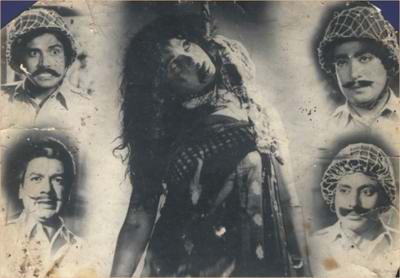 Ora Egaro Jon (1972): The first movie released on our Independence War, most of the lead roles were played by actors who actually fought against the Pakistani armed forces. Directed by Chashi Nazrul Islam, the movie is considered to be one of the best feature films based on the Liberation War. Khasru, Sumita Devi, and Shabana portrayed the lead roles in the film. Ora Egaro Jon (1972): The first movie released on our Independence War, most of the lead roles were played by actors who actually fought against the Pakistani armed forces. Directed by Chashi Nazrul Islam, the movie is considered to be one of the best feature films based on the Liberation War. Khasru, Sumita Devi, and Shabana portrayed the lead roles in the film.
Jibon Thekey Neya (1970): Zahir Raihan directed one of the most feted Bangla movies, Jibon Thekey Neya, featuring Khan Ataur Rahman, Rowshan Jamil, Anwar Hossain, Razzaque, and Suchanda. Raihan made a bold step with the movie by narrating the contemporary political turmoil in the then East Pakistan. The mass upsurge of 1969 was brilliantly captured in the movie by the ace filmmaker. The movie is also special for another reason: the National Anthem of Bangladesh, Amar Shonar Bangla Ami Tomae Bhalobashi was played for the first time in a Bangla movie and the song ignited the sense of Bangalee nationalism among the masses.
Documents on Crimes against Humanity Committed by Pakistan Army and their agents in Bangladesh during 1971
After 36 years of independence Jamaat-e-Islami Bangladesh now denies its anti-liberation role
Life for most people in Bangladesh seems to be getting harder each year. The endless traffic jams, dust pollution, roads always under construction, bad food, substandard medical facilities, vanishing greenery and the overwhelming lack of any security has been exponentially increasing over the decades since Independence. People in their thirties and older can clearly remember better days when food was not so expensive and adulterated, when the air was breathable, when there was a whole lot more space to walk around, basically when life was not so much a struggle. So what is the quality of life in Bangladesh after enjoying 33 years of independence? Just by looking at a few barometers that determine the standard of living one is forced to see reality: Bangladeshis, in general, are not getting any happier.
With very little money to spare, food is very basic at amost all common household. It consists of a breakfast of a wheat flour chapatti and tea, lunch with rice, lentils and vegetables (potato being the most common) and dinner almost the same diet as lunch. Chicken and meat are cooked only on special occasions such as Eid. Eggs are also too expensive at TK. 45 a dozen and even fish is out of reach. In the seventies Nurjahan's monthly salary was only Tk. 60 but even with this small amount food was not a problem for her household. A monthly ration card allowed her to get 12 kg of rice, 19 kg of wheat and 2 and a half kg of sugar. A hilsa cost about Tk 10 and spinach around Tk 1. In the 80s her monthly salary went up to Tk.200 but the cost of living was much higher. Nurjahan is much better off compared to the almost fifty percent who are below the poverty line and get to eat only one, that too not nutritionally balanced, meal a day.
The nutritional level of most people has significantly gone down over the last three decades leaving them weaker, with lower immunity to combat disease and illness. Studies show that about 700 children die each year from malnutrition. A United Nation report states that the average height of Bangladeshi youths have decreased by 10cm in less than 50 years due to malnutrition. Vitamin A deficiency (causing 30,000 children to go blind each year) as well as inadequate amounts of iron and iodine in the diet has caused physical weakness and reduced people's productivity. A Tk 640 crore National Nutrition Project launched in July 2000, aiming to reduce malnutrition in 105 upazilas could not start even after three years because of 'bureaucratic tangles'
Yet with all this we have continued to survive for more than three decades. As a people, Bangladeshis tend to be too accepting of subhuman standards, too resilient and much too tolerant of self-gratifying governments. Maybe that's just the problem.
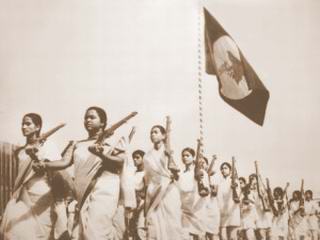 Fighting for your country's freedom is the greatest duty that one can perform. Yet, the successive governments have done little for the welfare of surviving freedom fighters. This shows that we have not only failed to live up to the dreams of those who've died for our homeland, but also failed to respect our past. We, as a nation should start correcting these grave errors right now, before it's too late and we realise what we have lost through our ignorance. Fighting for your country's freedom is the greatest duty that one can perform. Yet, the successive governments have done little for the welfare of surviving freedom fighters. This shows that we have not only failed to live up to the dreams of those who've died for our homeland, but also failed to respect our past. We, as a nation should start correcting these grave errors right now, before it's too late and we realise what we have lost through our ignorance.
The Liberation on Stamps
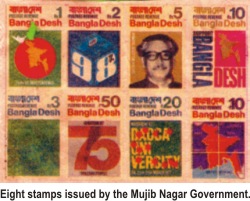 On Thursday July 29, 1971, a set of eight colourful commemorative stamps was issued and released from the Chuadanga Post Office which later became Mujib Nagar. On Thursday July 29, 1971, a set of eight colourful commemorative stamps was issued and released from the Chuadanga Post Office which later became Mujib Nagar.
The stamps symbolized the Liberation Movement and the birth of a new nation. With denominations of 10 paisa, 50 paisa, 1 taka, 2 taka, 3 taka, 5 taka and 10 taka, the stamps were printed in the offset printing method in the format of the International Security Printing Press of London.
Each stamp projects some significant part of our history of Independence.
This includes the map of Bangladesh was depicted in the 10 paisa stamp,
the blood shed in Dhaka University in the 20 paisa stamp,
a portrait of Bangabandhu (TK5 stamp),
the victory of Awami League in the elections by 98 percent of the votes (Tk2 stamp) and
the slogan 'Support Bangladesh' (Tk 10 stamp).
In order to ensure the regular printing of these stamps a high level committee was formed by barrister Moudud Ahmed. Other members of this committee were Patua Kamrul Hassan, Abdul Aziz, former SDO (Sub Divisional Officer)of Rajshahi and two high officials of the Postal Department Idrees Ali and Ashraf Ali. Those who were involved in publishing the stamps were Justice Abu Saeed Chaudhury (former President of Bangladesh), Hussain Ali Deputy High Commissioner and John Stonehouse, a former Member of Parliament and Postmaster General of London Post Office.
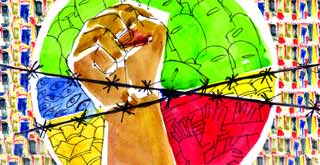 The people of Bangladesh, who secured military victory over the occupational army of Pakistan on this day 36 years ago with a view to politically organising themselves as a democratic republic to realise their political, economic and cultural potentials, are now reeling under the rule of an unelected authority, which is practically accountable to no one. The unelected authority, the ‘non-party caretaker government’ of Dr Fakhruddin Ahmed in other words, has been making decisions on matters of national importance without consulting the people – an idea which is absolutely inconsistent with the notion of democratic republicanism (Nurul Kabir, New Age, Dec16, 2007).
The people of Bangladesh, who secured military victory over the occupational army of Pakistan on this day 36 years ago with a view to politically organising themselves as a democratic republic to realise their political, economic and cultural potentials, are now reeling under the rule of an unelected authority, which is practically accountable to no one. The unelected authority, the ‘non-party caretaker government’ of Dr Fakhruddin Ahmed in other words, has been making decisions on matters of national importance without consulting the people – an idea which is absolutely inconsistent with the notion of democratic republicanism (Nurul Kabir, New Age, Dec16, 2007).
Unfreedom, 36 years on… by Nurul Kabir
Ekusher Prothom Kobita
Muktijuddha chronicles
The Battle of Hilli
A tragedy of our time
Filming liberation
The long shadow of the August 1975 coup- Mujibs Death
Back to Content
Last Modified August 4, 2014
|
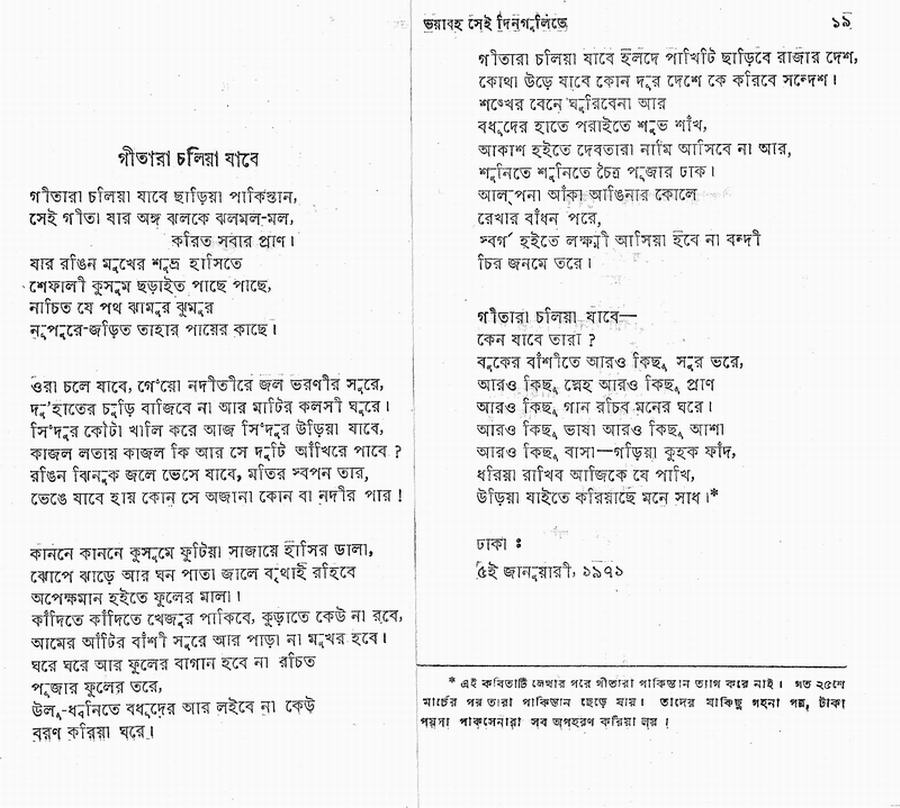
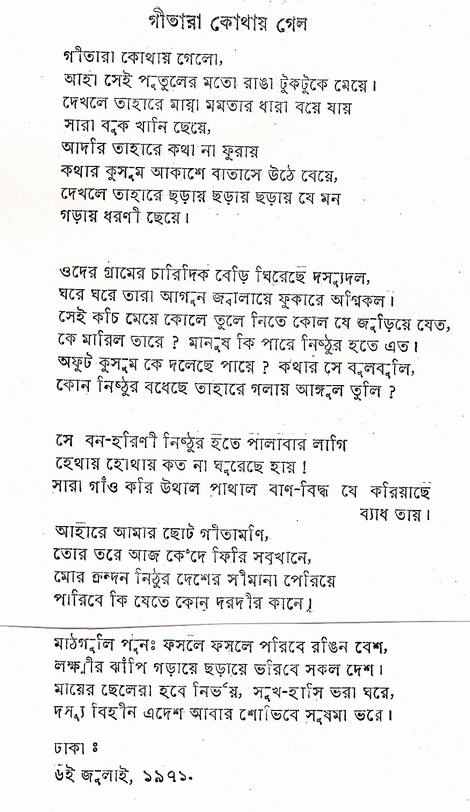
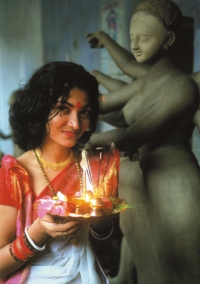
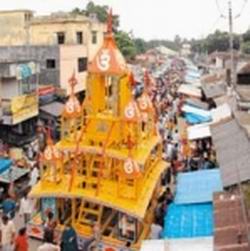
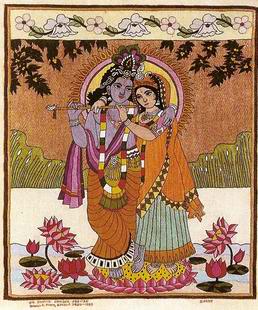
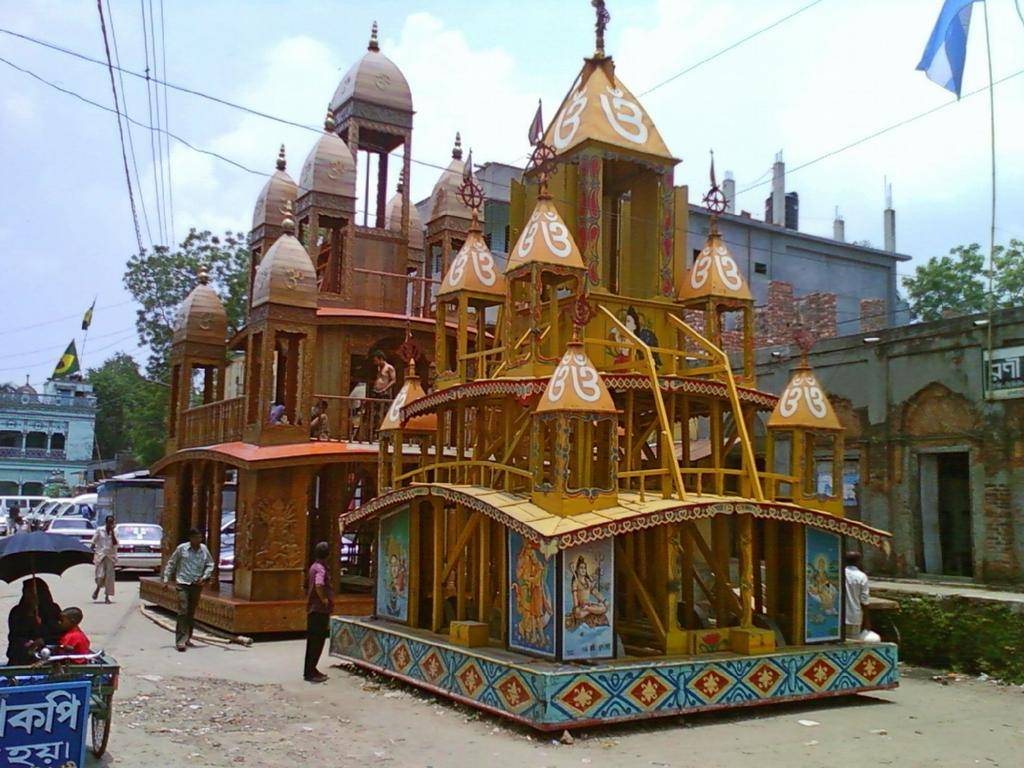

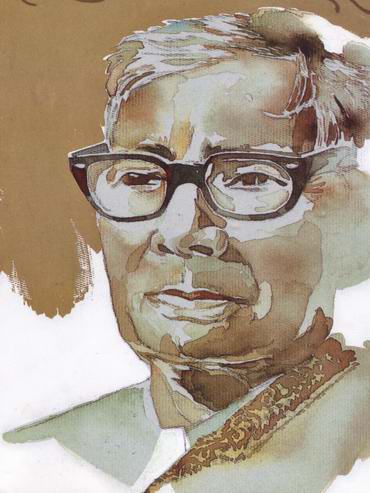
 When Bangladesh was liberated from the clutches of Punjabi-Sindhi cliques of Pakistani bourgeoisies in 1971, we were promised a society based on Democracy, Socialism, Nationalism and Secularism; that pledge has never come into being; on the contrary, with a heavy heart, we observe the advent of one military despot after another who whored our sacred constitution, plundered the country's national resources and had made it a hell for religious and ethnic minorities.
When Bangladesh was liberated from the clutches of Punjabi-Sindhi cliques of Pakistani bourgeoisies in 1971, we were promised a society based on Democracy, Socialism, Nationalism and Secularism; that pledge has never come into being; on the contrary, with a heavy heart, we observe the advent of one military despot after another who whored our sacred constitution, plundered the country's national resources and had made it a hell for religious and ethnic minorities.
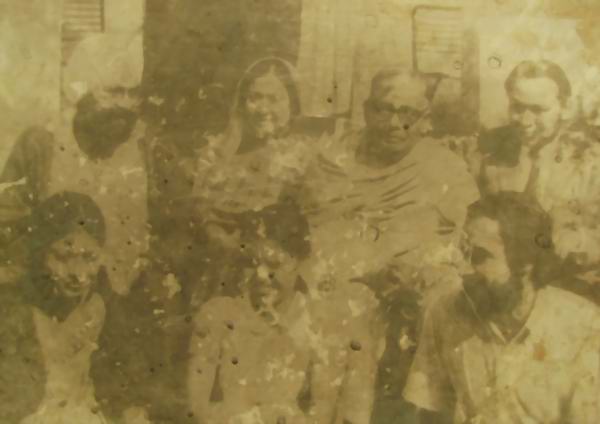
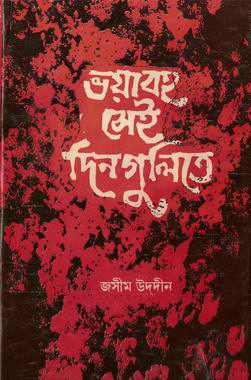 These poetries under the secrect name Tuzamber Ali were sent to Russia, America and India (during the war of independence). My daughter Hasna translated some poems into english distributed in the USA. These poetries translated into Russian were also popular in Russia. In India Sri Mulukraj Anand and other poets and writers acknowledged the poems with full appreciation.
These poetries under the secrect name Tuzamber Ali were sent to Russia, America and India (during the war of independence). My daughter Hasna translated some poems into english distributed in the USA. These poetries translated into Russian were also popular in Russia. In India Sri Mulukraj Anand and other poets and writers acknowledged the poems with full appreciation.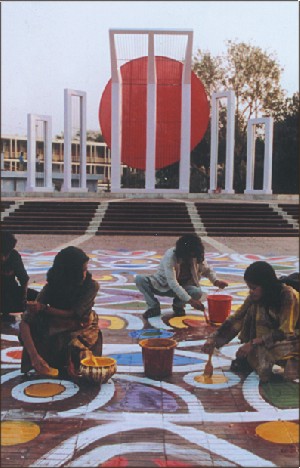 Jasim Uddin was the champion for the Bangladesh Freedom Movement taking the risk of publishing and distributing the Poems on War of Independence - about 17 poems all over the world, which created sympathy for liberation. The poems are (in bengali):
Jasim Uddin was the champion for the Bangladesh Freedom Movement taking the risk of publishing and distributing the Poems on War of Independence - about 17 poems all over the world, which created sympathy for liberation. The poems are (in bengali):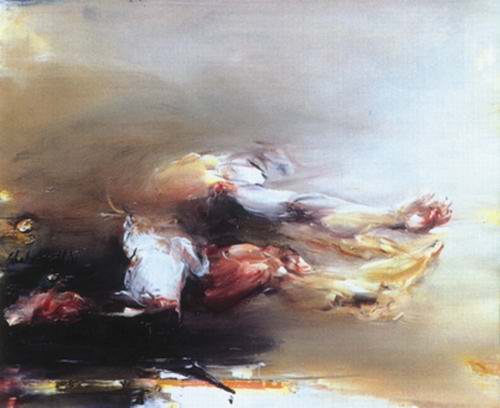
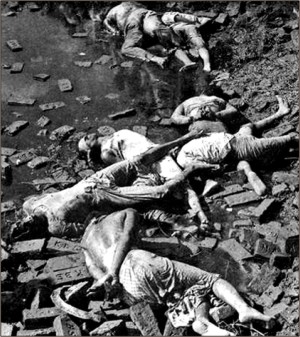 It was December 1971. The occupation army was coming near to a crushing defeat. The marauding forces were on the verge of turning tail. Sensing their impending danger, they hit upon a wicked plan to cripple our social and cultural advancement by killing the standard bearers of our country -- our intellectuals. They shot the last bolt. On December 14, the Pakistan army let loose the paramilitary units to kill the intellectuals -- teachers, politicians, scientists, physicians, lawyers, journalists, and others.
It was December 1971. The occupation army was coming near to a crushing defeat. The marauding forces were on the verge of turning tail. Sensing their impending danger, they hit upon a wicked plan to cripple our social and cultural advancement by killing the standard bearers of our country -- our intellectuals. They shot the last bolt. On December 14, the Pakistan army let loose the paramilitary units to kill the intellectuals -- teachers, politicians, scientists, physicians, lawyers, journalists, and others.
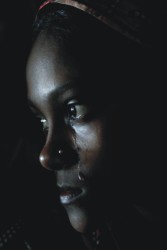 The way the highly valued children of our soil were killed was diabolical. They were rounded up like cattle, bound, blindfolded, and led to torture chambers at Mirpur, Muhammadpur, Nakhalpara, Razarbag, and finally taken to Rayerbazar, where they were gunned down like sitting ducks.
The way the highly valued children of our soil were killed was diabolical. They were rounded up like cattle, bound, blindfolded, and led to torture chambers at Mirpur, Muhammadpur, Nakhalpara, Razarbag, and finally taken to Rayerbazar, where they were gunned down like sitting ducks.
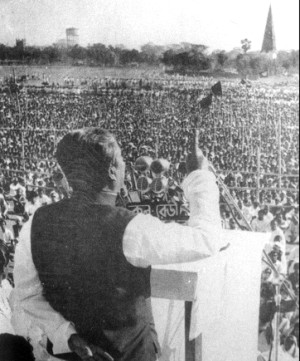 Bangladesh has emerged as a result of long years of struggle, sacrifice and bloodshed. Its creation was not an accident of history where people living in a particular geographical area were just granted independence by a weary colonial power. Bangladesh liberated itself from the occupation of another state, Pakistan. Therefore, it had to define its identity before it could exist as a nation, and its people had to identify with their new national consciousness and clear individuality. At the birth of Bangladesh - out of the fire and blood of a liberation war - its entire people were aware that they were citizens of a new nation, and could identify with their nation.
Bangladesh has emerged as a result of long years of struggle, sacrifice and bloodshed. Its creation was not an accident of history where people living in a particular geographical area were just granted independence by a weary colonial power. Bangladesh liberated itself from the occupation of another state, Pakistan. Therefore, it had to define its identity before it could exist as a nation, and its people had to identify with their new national consciousness and clear individuality. At the birth of Bangladesh - out of the fire and blood of a liberation war - its entire people were aware that they were citizens of a new nation, and could identify with their nation. 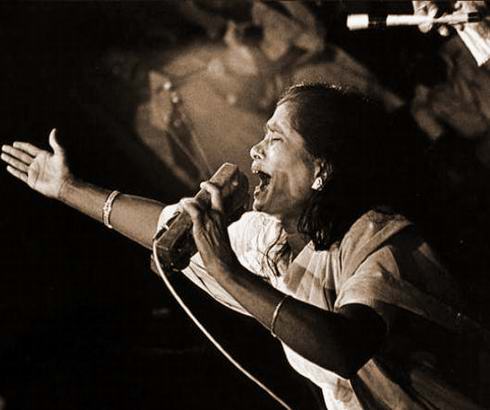 Independence of Bangladesh itself has been a statement--that a state cannot be run on the basis of religion alone, it should take into account other factors like language and ethnicity into consideration. It is no surprise then that the first constitution of Bangladesh rightly incorporated secularism as one of the guiding principles of the new country.
Religion, however, made a quick come back into the country's politics in the aftermath of the murder of Bangabandhu Sheikh Mujibur Rahman. Gen Ziaur Rahman, who seized power after a bloody coup in 1975, indemnified the killers of Sheikh Mujib and removed secularism from the constitution for "Complete faith and Trust in Allah". From war criminals to frustrated Marxists Zia had a place for everyone in his new political bloc-- he practically rehabilitated big war criminals, some of them in his own cabinet. In the politics of his wife Khaleda Zia, war criminals have been crucial to consolidating power.
Independence of Bangladesh itself has been a statement--that a state cannot be run on the basis of religion alone, it should take into account other factors like language and ethnicity into consideration. It is no surprise then that the first constitution of Bangladesh rightly incorporated secularism as one of the guiding principles of the new country.
Religion, however, made a quick come back into the country's politics in the aftermath of the murder of Bangabandhu Sheikh Mujibur Rahman. Gen Ziaur Rahman, who seized power after a bloody coup in 1975, indemnified the killers of Sheikh Mujib and removed secularism from the constitution for "Complete faith and Trust in Allah". From war criminals to frustrated Marxists Zia had a place for everyone in his new political bloc-- he practically rehabilitated big war criminals, some of them in his own cabinet. In the politics of his wife Khaleda Zia, war criminals have been crucial to consolidating power.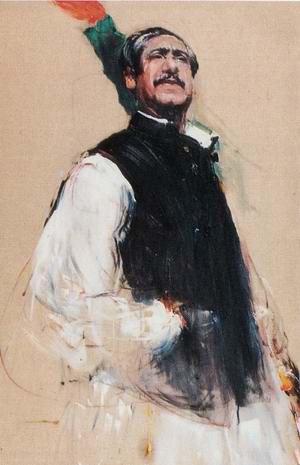
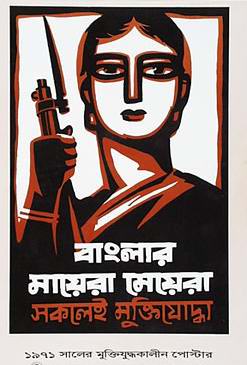
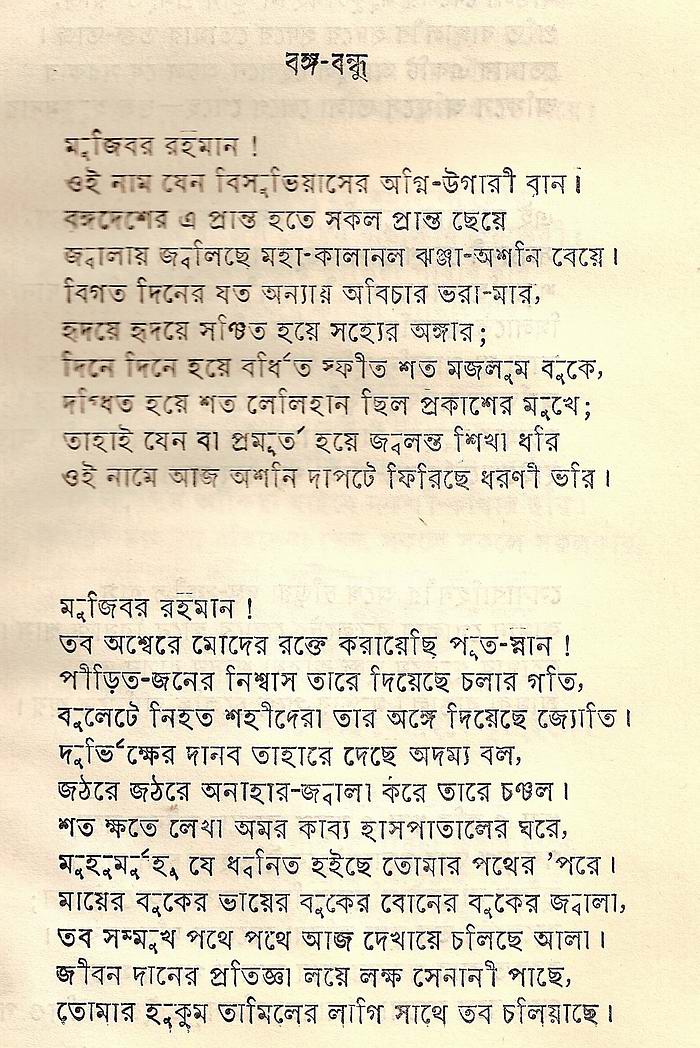
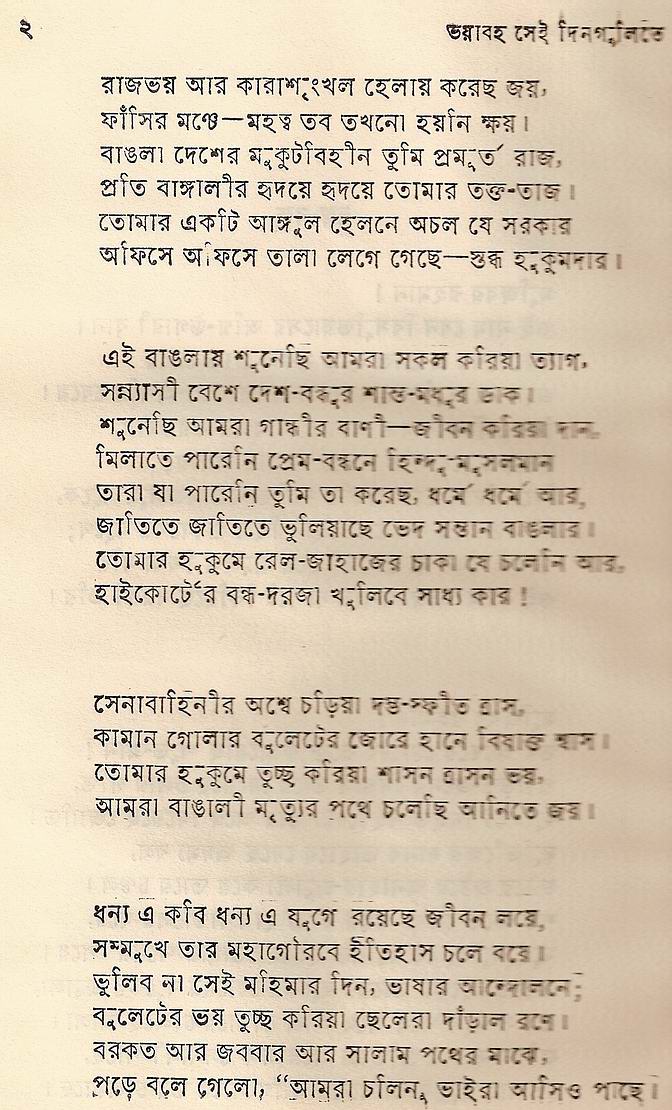
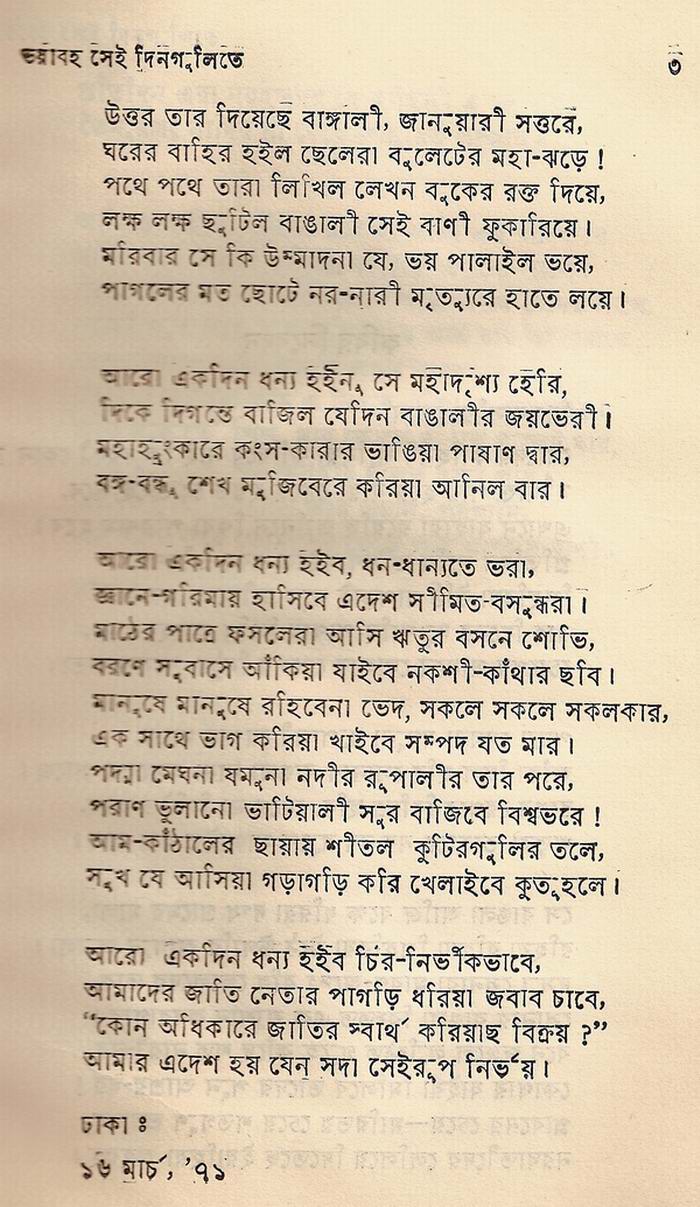
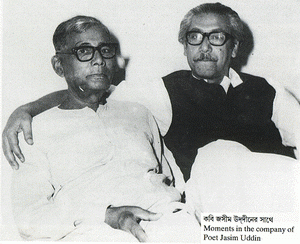
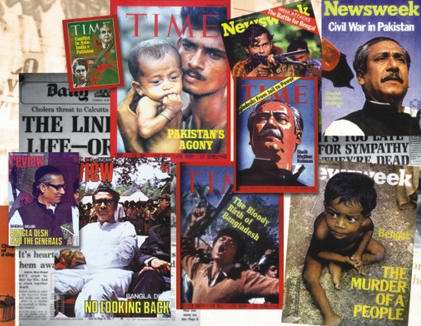
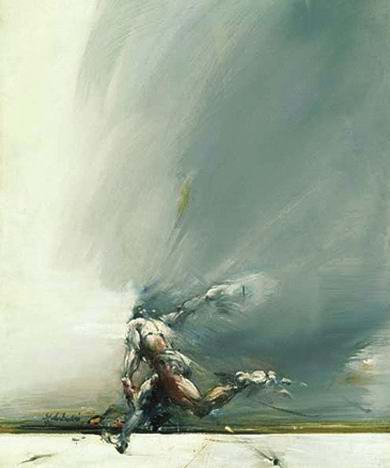
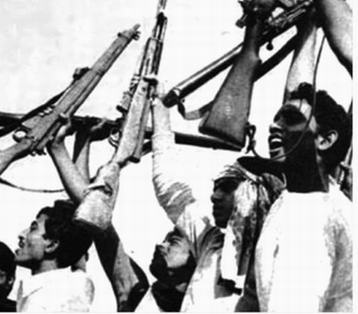
 *
The word 'Lakshmi' is derived from the Sanskrit word Laksya, meaning 'aim' or 'goal', and she is the goddess of wealth and prosperity, both material and spiritual.
Lakshmi is the household goddess of most Hindu families, and a favorite of women. Although she is worshipped daily, the festive month of October is Lakshmi's special month. Lakshmi Puja is celebrated on the full moon night of Kojagari Purnima.
*
The word 'Lakshmi' is derived from the Sanskrit word Laksya, meaning 'aim' or 'goal', and she is the goddess of wealth and prosperity, both material and spiritual.
Lakshmi is the household goddess of most Hindu families, and a favorite of women. Although she is worshipped daily, the festive month of October is Lakshmi's special month. Lakshmi Puja is celebrated on the full moon night of Kojagari Purnima.
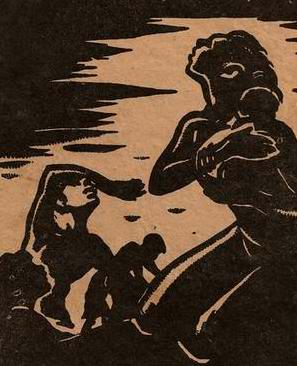
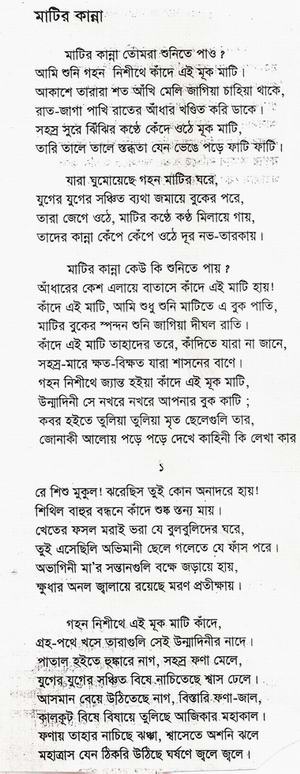

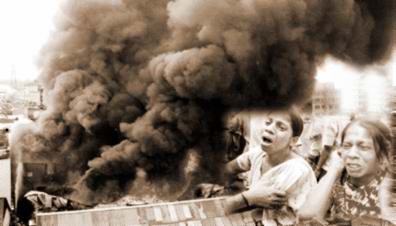
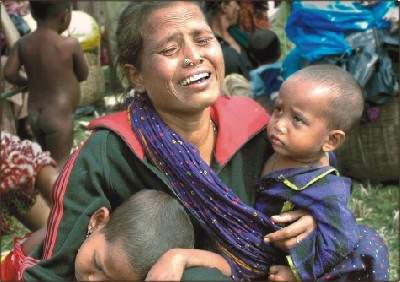
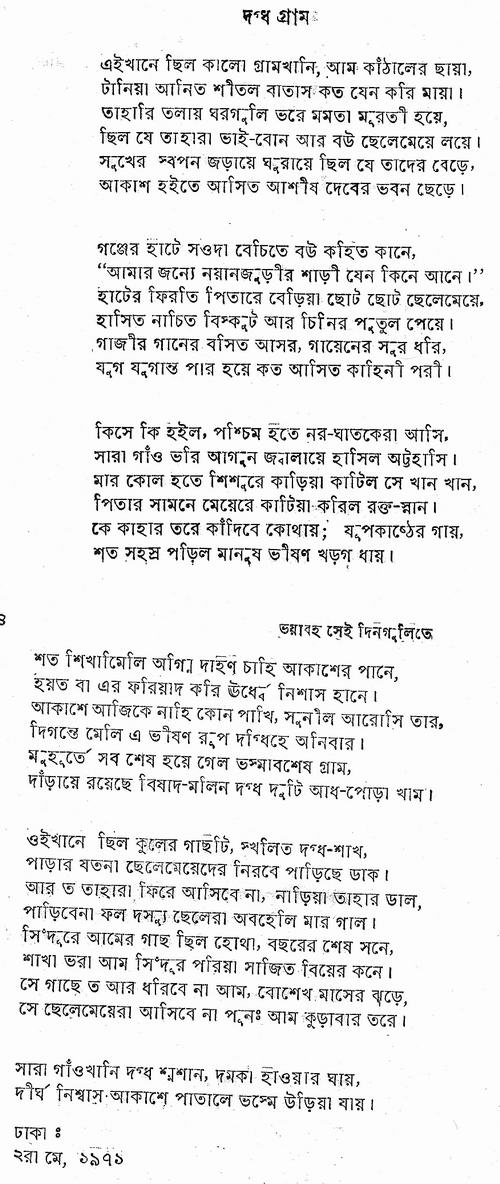
 Where is Mina gone?
Where is Mina gone?
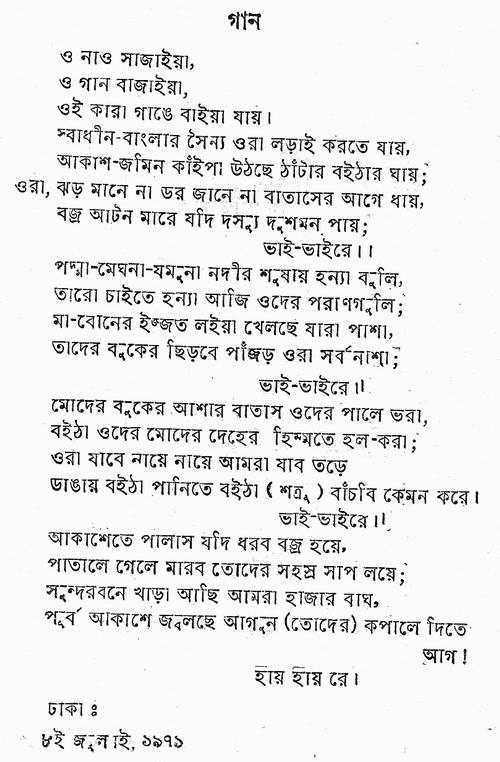
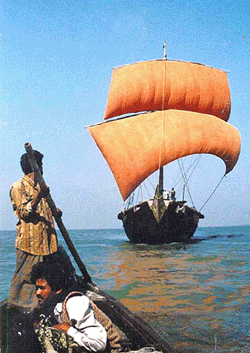
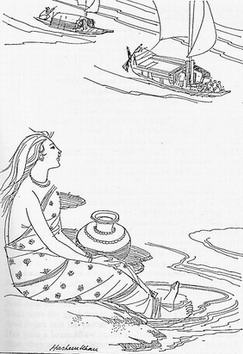

 Each individual has the knowledge of good or bad and for the singers and the spectators or the audience of Gazir Gaan, the performance is as recreational as it is of devotion. Some show their devotion by praying, some by worshiping (Puja), some by offering a particular sacrifice to the deity on fulfillment of a prayer (Manot) and some may look for some other way to express their devotion. Gazir Gaan, whatsoever includes humour or even obscenity, ultimately it is something of sheer devotion.
Each individual has the knowledge of good or bad and for the singers and the spectators or the audience of Gazir Gaan, the performance is as recreational as it is of devotion. Some show their devotion by praying, some by worshiping (Puja), some by offering a particular sacrifice to the deity on fulfillment of a prayer (Manot) and some may look for some other way to express their devotion. Gazir Gaan, whatsoever includes humour or even obscenity, ultimately it is something of sheer devotion. 



 When we talk about patchitra, first of all, the images of Kalighater pats come in our mind. This genre of painting developed in the nineteenth century which flourished in the market places around the Kalighat Mandir on the bank of the Ganges in Kolkata. But according some historians, older than the Kalighater pat were Gazir pats which most probably emerged around the 16th century. Unlike the Kalighater pat, the uniqueness of Gazir pat is of profound importance and influence in the history of painting and literature in Bengal both in subject and form. The scroll paintings of Gazir pat (pat meaning cloth), present the valour of legendary figure Gazi Pir, who was respected and worshiped as a warrior-saint.
When we talk about patchitra, first of all, the images of Kalighater pats come in our mind. This genre of painting developed in the nineteenth century which flourished in the market places around the Kalighat Mandir on the bank of the Ganges in Kolkata. But according some historians, older than the Kalighater pat were Gazir pats which most probably emerged around the 16th century. Unlike the Kalighater pat, the uniqueness of Gazir pat is of profound importance and influence in the history of painting and literature in Bengal both in subject and form. The scroll paintings of Gazir pat (pat meaning cloth), present the valour of legendary figure Gazi Pir, who was respected and worshiped as a warrior-saint.
 Red and blue are the two pigments mainly used in the pats. There are slight variations of colour, with crimson and pink from red, and grey and sky-blue from blue. Every figure is flat and two-dimensional. In order to bring in variety, various abstract designs (such as diagonal, vertical and horizontal lines and small circles) are often used. Trees, Gazi? mace, the tasbih or prayer beads, birds, deer, hookahs etc, are extremely stylised. The figures of Gazi, his disciples Kalu and Manik Pir, Jama? (the Hindu god of death) messengers, etc appear rigid and lifeless. Though there is no attempt at realism in the images of Gazir pats, the sort of painting has a time value as primitive work.
Red and blue are the two pigments mainly used in the pats. There are slight variations of colour, with crimson and pink from red, and grey and sky-blue from blue. Every figure is flat and two-dimensional. In order to bring in variety, various abstract designs (such as diagonal, vertical and horizontal lines and small circles) are often used. Trees, Gazi? mace, the tasbih or prayer beads, birds, deer, hookahs etc, are extremely stylised. The figures of Gazi, his disciples Kalu and Manik Pir, Jama? (the Hindu god of death) messengers, etc appear rigid and lifeless. Though there is no attempt at realism in the images of Gazir pats, the sort of painting has a time value as primitive work.
 One of the most striking exhibits in the current British Museum exhibition Myths of Bengal is the beautiful Gazi scroll - not just for its rich colours and vivid figures, but because it illustrates the enriching coexistence of two of the world's great faiths. Images of Hindus making puja offerings are juxtaposed with those of Muslims making similar offerings at the tombs of their saints (pirs). It shows how a remarkable, syncretic culture emerged in which the tombs of many pirs became places of pilgrimage for both Hindus and Muslims.
One of the most striking exhibits in the current British Museum exhibition Myths of Bengal is the beautiful Gazi scroll - not just for its rich colours and vivid figures, but because it illustrates the enriching coexistence of two of the world's great faiths. Images of Hindus making puja offerings are juxtaposed with those of Muslims making similar offerings at the tombs of their saints (pirs). It shows how a remarkable, syncretic culture emerged in which the tombs of many pirs became places of pilgrimage for both Hindus and Muslims.



 The collaborators helped the Pak Army to find those on their deadly list, round them up or abduct them and then take them to various places where the victims were brutally tortured and murdered. Their bodies were dumped in various killing fields, the most infamous one being the Rayerbazar Bodhobhumi (killing field) where the mutilated bodies of victims were later found. Many of the bodies were unrecognisable, some had body parts missing, while others' eyes had been gouged out. Among the victims were many intellectuals, university professors, doctors, writers and journalists. The bodies of other victims were never found. The Pak Army and their collaborators also picked up many women and young girls who were subjected to systematic rape and torture.
The collaborators helped the Pak Army to find those on their deadly list, round them up or abduct them and then take them to various places where the victims were brutally tortured and murdered. Their bodies were dumped in various killing fields, the most infamous one being the Rayerbazar Bodhobhumi (killing field) where the mutilated bodies of victims were later found. Many of the bodies were unrecognisable, some had body parts missing, while others' eyes had been gouged out. Among the victims were many intellectuals, university professors, doctors, writers and journalists. The bodies of other victims were never found. The Pak Army and their collaborators also picked up many women and young girls who were subjected to systematic rape and torture.
 On March 25, the Pakistan Army launched a terror campaign calculated to intimidate the Bengalis into submission. Within hours a wholesale slaughter had commenced in Dhaka, with the heaviest attacks concentrated on the University of Dhaka and the Hindu area of the old town. Bangladeshis remember the date as a day of infamy and liberation. The Pakistan Army came with hit lists and systematically killed several hundred Bengalis. Mujib was captured and flown to West Pakistan for incarceration.
On March 25, the Pakistan Army launched a terror campaign calculated to intimidate the Bengalis into submission. Within hours a wholesale slaughter had commenced in Dhaka, with the heaviest attacks concentrated on the University of Dhaka and the Hindu area of the old town. Bangladeshis remember the date as a day of infamy and liberation. The Pakistan Army came with hit lists and systematically killed several hundred Bengalis. Mujib was captured and flown to West Pakistan for incarceration.
 After the tragic events of March, India became vocal in its condemnation of Pakistan. An immense flood of East Pakistani refugees, between 8 and 10 million according to various estimates, fled across the border into the Indian state of West Bengal. In April an Indian parliamentary resolution demanded that Prime Minister Indira Gandhi supply aid to the rebels in East Pakistan. She complied but declined to recognize the provisional government of independent Bangladesh.
After the tragic events of March, India became vocal in its condemnation of Pakistan. An immense flood of East Pakistani refugees, between 8 and 10 million according to various estimates, fled across the border into the Indian state of West Bengal. In April an Indian parliamentary resolution demanded that Prime Minister Indira Gandhi supply aid to the rebels in East Pakistan. She complied but declined to recognize the provisional government of independent Bangladesh.
 Ora Egaro Jon (1972): The first movie released on our Independence War, most of the lead roles were played by actors who actually fought against the Pakistani armed forces. Directed by Chashi Nazrul Islam, the movie is considered to be one of the best feature films based on the Liberation War. Khasru, Sumita Devi, and Shabana portrayed the lead roles in the film.
Ora Egaro Jon (1972): The first movie released on our Independence War, most of the lead roles were played by actors who actually fought against the Pakistani armed forces. Directed by Chashi Nazrul Islam, the movie is considered to be one of the best feature films based on the Liberation War. Khasru, Sumita Devi, and Shabana portrayed the lead roles in the film.
 Fighting for your country's freedom is the greatest duty that one can perform. Yet, the successive governments have done little for the welfare of surviving freedom fighters. This shows that we have not only failed to live up to the dreams of those who've died for our homeland, but also failed to respect our past. We, as a nation should start correcting these grave errors right now, before it's too late and we realise what we have lost through our ignorance.
Fighting for your country's freedom is the greatest duty that one can perform. Yet, the successive governments have done little for the welfare of surviving freedom fighters. This shows that we have not only failed to live up to the dreams of those who've died for our homeland, but also failed to respect our past. We, as a nation should start correcting these grave errors right now, before it's too late and we realise what we have lost through our ignorance.
 On Thursday July 29, 1971, a set of eight colourful commemorative stamps was issued and released from the Chuadanga Post Office which later became Mujib Nagar.
On Thursday July 29, 1971, a set of eight colourful commemorative stamps was issued and released from the Chuadanga Post Office which later became Mujib Nagar.
 The people of Bangladesh, who secured military victory over the occupational army of Pakistan on this day 36 years ago with a view to politically organising themselves as a democratic republic to realise their political, economic and cultural potentials, are now reeling under the rule of an unelected authority, which is practically accountable to no one. The unelected authority, the ‘non-party caretaker government’ of Dr Fakhruddin Ahmed in other words, has been making decisions on matters of national importance without consulting the people – an idea which is absolutely inconsistent with the notion of democratic republicanism (Nurul Kabir, New Age, Dec16, 2007).
The people of Bangladesh, who secured military victory over the occupational army of Pakistan on this day 36 years ago with a view to politically organising themselves as a democratic republic to realise their political, economic and cultural potentials, are now reeling under the rule of an unelected authority, which is practically accountable to no one. The unelected authority, the ‘non-party caretaker government’ of Dr Fakhruddin Ahmed in other words, has been making decisions on matters of national importance without consulting the people – an idea which is absolutely inconsistent with the notion of democratic republicanism (Nurul Kabir, New Age, Dec16, 2007).